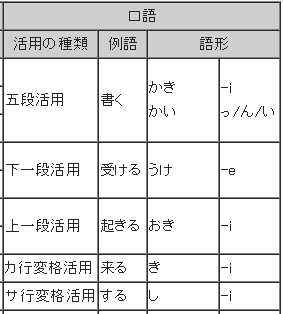In so-called 学校文法 (the Japanese grammar which all native Japanese speakers learn at around middle school), one form of a verb is called 連用形 (aka continuative form), which looks like this (screenshot from 連用形 on Japanese Wikipedia):
As you can see, there are actually two forms of 連用形 for 五段活用 verbs (aka Group 1 verbs, consonant-stem verbs, or u-verbs). One is rather simple (changing the last -u to -i), but the other form is heavily influenced by sound changes called 音便.
Until very recently, I had believed that masu-form and te-form are the simple, straightforward terms to distinguish the two forms 連用形 listed above. I believed they are the direct subset of 連用形. 書き is the masu-form of 書く, 書い is the te-form of 書く, 立ち is the masu-form of 立つ, 立っ is the te-form of 立つ, and so on. The masu-form is called masu-form because it's typically followed by ます, and the te-form is called te-form because it's typically followed by て/で.
And finally, I realized I was wrong. If I say "te-form", listeners imagine it also includes the て/で part. I checked several free learning sites for Japanese-as-the-second-language learners and found these names (taking 読む as an example verb):
- 読み: i-form (WP), stem (CC), verb stem (TK), 連用形 (TUFS), masu-stem, 連用形 (学校文法)
- 読みます: i-form + masu (WP), masu-form (CC, LJA), polite form = verb stem + masu (TK), ます形 (TUFS), 連用形+助動詞"ます" (学校文法)
- 読ん: N/A (WP, CC, LJA, TK, TUFS), 連用形 (学校文法)
- 読んだ: perfective-form (WP), ta-form (CC, LJA), past tense (TK), た形 (TUFS), 連用形+助動詞"だ" (学校文法)
- 読んで: te-form (WP, CC, LJA, TK), て形 (TUFS), 連用形+接続助詞"で" (学校文法)
(WP: English Wikipedia, CC: CosCom, LJA: learn-japanese-adventure.com, TK: Tae Kim's Guide to Learning Japanese, TUFS: 東京外国語大学言語モジュール)
So, what I believed was te-form is not te-form, and it doesn't even have an English name! (It can be confirmed by this question.) ます/て/で are not even considered as distinct "words" here; they are considered as a part of the conjugation of a verb. In monolingual dictionaries, ます, て/で and た/だ are all distinct words (either 助動詞 or 接続助詞) that attach 連用形.
Questions
- Does "te-form" really only mean the form including て/で, regardless of the school/faction? If I say "読ん is the te-form of 読む" or "読み is the masu-form of 読む", am I totally wrong?
- Is there any practical reason for not having a name for 読ん/立っ/etc and thinking of 読んだ and 読んで as different "forms"?
- I understand that there is no single "correct grammar of Japanese", but what is the historical cause of this discrepancy? Perhaps someone was not satisfied with the Japanese grammar invented by Japanese people, and published a book with his own grammar in the past?
(PS: I'm not willing to keep using confusing terms. I just want to know the best words for learners, and, hopefully, help future native Japanese answerers who haven't heard of "te-form" or "masu-form" at all.)

